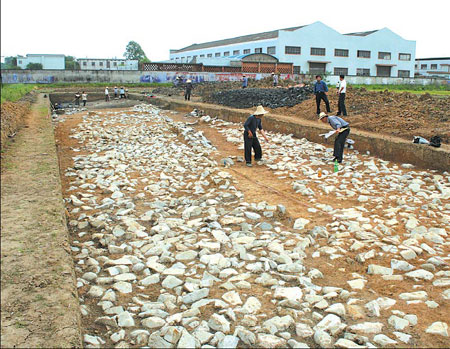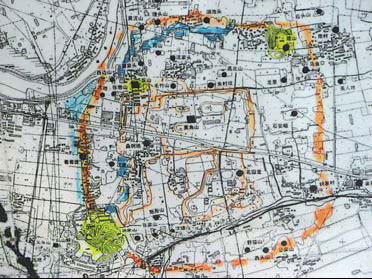|
|

Archeological site of an ancient city in Yuhang county |
The Zhejiang Archaeological Institute sparked widespread interest in Liangzhu Culture late last year when they announced the discovery of ruins of an ancient city.
Relics found at the base of an ancient city wall in Yuhang, a county of Hangzhou in Zhejiang province led scientists to believe previously discovered ruins belong to the Liangzhu Culture (3400-2250 BC), the last Neolithic jade culture in the Yangtze River Delta.

The latest discoveries were first unearthed in 2006 during excavation work for apartment buildings in Putaoban village of Yuhang.
Archaeologists were called in because the village is part of the Neolithic Liangzhu Culture protection zone.
Under a rice field archaeologists then found a 40-m-wide, 1-m-deep ancient ditch made of hardened earth that held large numbers of pottery shards classified as belonging to the Liangzhu Culture.
When archaeologists dug a deep hole on the bank beside the ditch, they were surprised to find the high land next to it was actually built of hammered soil and laid with pebbles at the bottom.
Locals say such stones - with clear edges and corners and apparently processed by hand - were spotted elsewhere in the region.
Based on these clues, archaeologists came to a preliminary assumption that the high land where the Putaoban village is located could be a manmade river embankment from the Liangzhu Culture period.
Some archaeologists made even bolder assumptions that the ruins, located only 200 m to the west of the Mojiaoshan archaeological site, could be a section of city wall that many historians have believed existed and have searched for.
Mojiaoshan, a 300,000-sq-m pounded earth platform built during the Chalcolithic period (3300-2000 BC), is part of a Liangzhu complex site at Yuhang in Zhejiang.
Inspired by the findings, the Zhejiang Archaeological Institute undertook a careful excavation surrounding Mojiaoshan.
Starting from the raised earth in Putaoban village, archaeologists followed the pebbles at the bottom of the remains. By last April they were certain that a section of 1,000 m long and 40 to 60 m wide belongs to the Liangzhu period.
By last November it was almost certain that the old city was protected by four walls built of stones at their base and yellow clay in the walls themselves.
Covering an area of 2.9 million sq m, roughly four times the size of the Forbidden City in Beijing, the Liangzhu site is the largest Neolithic settlement discovered in China.
Through analysis of pottery shards excavated outside the walls, scientists estimate the city fell into disuse around 4,200 years ago. Its exact time of construction, estimated to start from 5,000 years ago, needs further study.
There is also evidence that the city was well planned. Its walls were not only defensive for military purposes, but also offered protection from natural disasters such as floods.
It was already known that Mojiaoshan and the possible remains of a palace from the Liangzhu Culture period are the centerpiece of a culture that dates back more than 5,300 years. Ruins of a sacrificial altar and tombs were found earlier within or around the site .
It could be called "China's first city", said State Cultural Relics Bureau expert Zhang Zhongpei. "It is unique in the country, with its value comparable to Yinxu."
Yinxu, a palace in the late Shang Dynasty (c. 16th century-11th century BC) located in what is now Henan province, is one of the oldest and largest archaeological sites in China. It is considered one of the ancient capitals of China and a UNESCO World Heritage Site.
Other historians made even wider speculation. "The Liangzhu ancient city could have been the capital of a Liangzhu Kingdom," said Yan Wenming, a professor with Peking University.
Historians have long speculated about the existence of such a kingdom four millennia ago, said Liu Qingzhu, director of the Archaeological Research Institute of the Chinese Academy of Social Sciences.
Further evidence is needed to prove the city was the capital of a possible kingdom, he said. "There should be remains of palaces if there was political power. The essence of statehood lies in its government, not just in the walls."
If a political power existed so long ago on the east coast, it is a mystery why it faded away. But the discovery has generated streams of visiting government officials, scholars, the media and an interested public.
The Liangzhu Culture Museum, already popular with history buffs and lovers of jade and antiques, has received more than double the number of visitors following the discovery.
Liangzhu Culture
Named after the locale where it was first discovered in 1936, Liangzhu Culture dates back to 3310 - 2250 BC. Chinese historians generally regard it as the first peak of Hangzhou's development. The civilization's history can be traced further back to 8,000 year ago, starting with the Kuahuqiao Culture that lived in what is now the city's suburban Xiaoshan district.
The ruins are 20 km northwest of the city center. Surrounded by mountains, more than 130 Liangzhu Culture sites are scattered over an area of 40 sq km.
Liangzhu Culture had advanced agriculture including irrigation, paddy rice cultivation and aquaculture.
Yet to many the most remarkable feature of Liangzhu Culture is the huge number and high quality of green jade artifacts, and their religious importance.
Two types of jade, called bi and cong, were used ritually by the ancient culture.
Bi jade circular rings were used to worship heaven and cong was an elongated square used to worship the earth.
Over 5,000 jades have been discovered in the Liangzhu ruins to date. The congs have the earliest known beast designs for masks as a part of their inscriptions.
Liangzhu Culture also had broad division of labor, which gave rise to rapid polarization of classes.
Hangzhou China Travel Service:0086-571-88398499; 0086-13588476467 (24h) |


